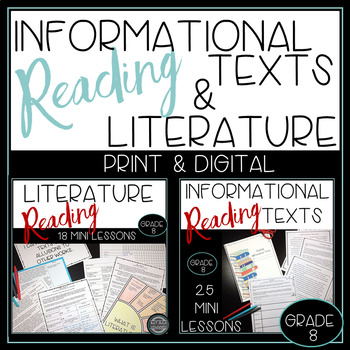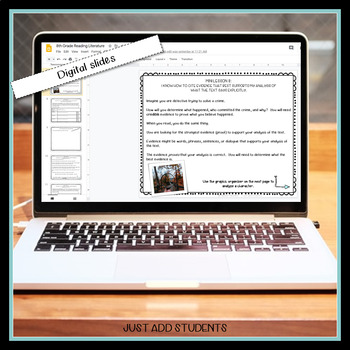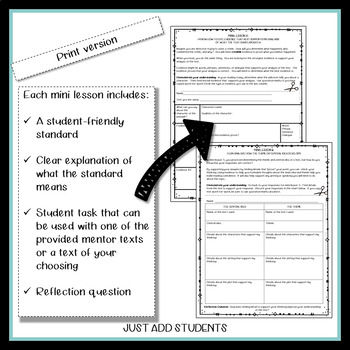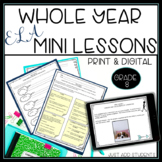Reading Information & Literature Mini Lesson Whole Year Bundle Grade 8
- Zip

What educators are saying
Products in this Bundle (2)
Also included in
- Everything you need to teach 8th grade ELAR! All the CCSS are addressed with this gigantic bundle! You'll be set for the year with all the mini lessons, lesson plans, checklists, and mentor texts. Digital and Print.This is going to save you so much time!This is what you'll get:Reading Literature (Price $60.00Original Price $75.93Save $15.93
Description
Digital + Print! No planning! Save tons of time using these mini lessons to teach all your 8th grade reading information texts and reading literature lessons! Spend more time helping your students and less time planning and searching for resources!
Plus, you can use these lessons with any texts.
You'll be able to:
- scaffold
- differentiate
- workshop
- conference
- work on test prep
- and dig down into those reading skills every day without a ton of work!
You'll love that this resource gets you back to teaching -- no more hunting for resources to teach ALL of the Reading Informational Texts and Reading Literature standards.
This print & digital bundle includes 53 mini lessons, lesson plans, mentor texts, answer keys, and teacher checklists that will make teaching both the RI and RL standards fun and easy.
What you get in the Reading Informational Texts Resource:
- 25 Mini Lessons -- both print & digital
- Two cover choices (one full-color, one blackline) that you can use to create a workbook for your students
- 25 standards posters written in student-friendly language
- four nonfiction texts that you can use right away to start teaching these skills! Included two texts that argue opposite points.
- lesson planning charts
- Answer Key using the nonfiction texts in the zip file. This will give you an idea of how to use the mini lessons with other texts. You may wish to choose your own nonfiction texts.
- Editable teacher checklist that will help you track what lessons your students have completed - great for differentiation!
- teaching tips and video to help you get the most out of this jam-packed resource!
Each mini lesson includes:
- a manageable portion of the RI standards
- student friendly restatement of the standard
- easy-to-follow explanation of the standard
- a “Demonstrate your Understanding” that directs the student’s task for the day
- print version: students can cut off the bottom portion of the page to use as an exit card or assessment
- digital version: students can turn in the activity they completed
- students can add notes for each lesson to a digital or print notebook to create a reading resource
- a “Reflection Question” focuses on higher order thinking skills and helps summarize the mini lesson. Ideal "wrap up" or use as a warm up for the next class.
The 25 mini lessons address:
1. central idea & textual evidence
2. inference based on evidence
3. development of the central idea & supporting details
4. objective summary
5. comparisons, analogies, categories
6. text connections & distinctions between individuals
7. text connections & distinctions between ideas
8. text connections & distinctions between events
9. vocabulary clarification
10. figurative language
11. connotative meaning
12. technical language
13. distinguishing figurative, connotative, and technical language
14. word choice and tone
15. paragraph structure
16. sentence and paragraph development
17. point of view
18. author's response to opposing evidence
19. advantages of various media presentations
20. disadvantages of various media presentations
21. deconstruct and evaluate an argument
22. assess argument's validity
23. evaluate conflicting information on the same topic
24. evaluate points in opposing arguments that differ
25. assessing the variety of nonfiction texts that challenge the reader
What you get in the Reading Literature Resource:
- 18 Mini Lessons + 5 extra practice lessons
- Digital & print - perfect for blended, distance, or in-person learning!
- 18 standards posters written in student-friendly language
- lesson planning charts
- the short stories "The Cask of Amontillado" and "The Last Leaf." You can use them right away to start teaching these skills!
- Additional texts are embedded into several lessons.
- Answer Key using the fiction text in the zip file. This will give you an idea of how to use the mini lessons with other texts. You may wish to choose your own literary texts.
- Teacher checklist that will help you track what lessons your students have completed - great for differentiation!
Each mini lesson includes:
- a manageable portion of the RL standards
- student friendly restatement of the standard
- easy-to-follow explanation of the standard
- A “Demonstrate your Understanding” that directs the student’s task for the day
- Built in assessments -- students can cut off the bottom portion of the page -- or submit the digital slide
- A “Reflection Question” focuses on higher order thinking skills and helps summarize the mini lesson. Ideal "wrap up" or use as a warm up for the next class.
The 18 mini lessons address:
- What is Literature? Anchor chart
- Provide an objective Summary
- Cite textual evidence – providing explicit evidence
- Cite textual evidence for inferences
- Determine the central idea of the text (+ extra practice)
- Analyze theme and central idea over the course of the text
- Analyze dialogue
- Analyze incidents
- Determine meaning of words & phrases
- Determine figurative & connotative meaning
- Analyze word choice (+ extra practice)
- Compare structure of two texts
- Contrast structure of two texts (+ extra practice)
- What is irony?
- Analyze different points of view (+ extra practice)
- Analyze how a film is adapted from a text
- Analyze how fiction draws on other works (+ extra practice)
- Reading complexity - Survey
Use with any texts or the ones I've provided. Perfect for scaffolding, differentiation, reteaching, literature circles, literature centers, and whole class instruction.
This is going to save you so much time!
You might also be interested in my other mini lessons, and:
I'd love for you to follow my store -- and be the first to learn about sales, new products, and freebies! Just click on the little star to do just that!
I can't wait to hear from you! I read and respond to all feedback! And if you have any questions, just pop them in the Q&A below and I'll get right back to you!
Happiness always,
Marypat






